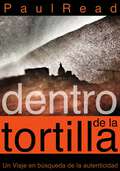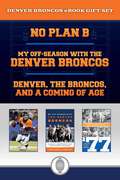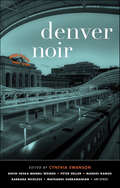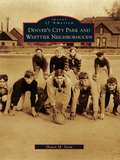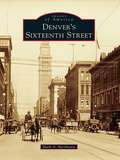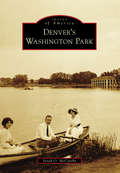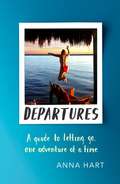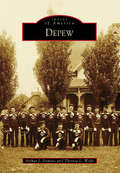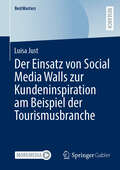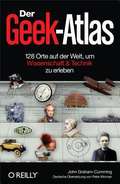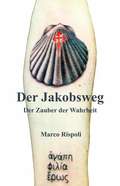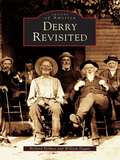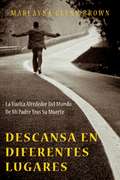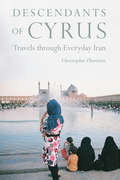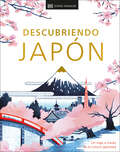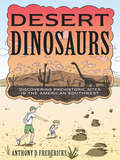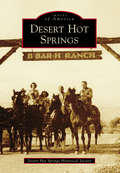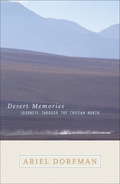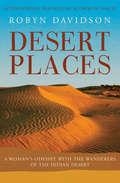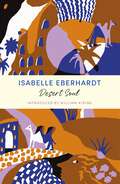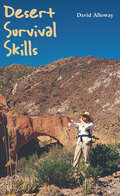- Table View
- List View
Dentro de la tortilla: Un viaje en búsqueda de la autenticidad
by Paul ReadLa vida tiene un hábito de aventar obstáculos a tu camino por una buena razón: Existen para retar al no intimidado o disuadir al no comprometido. De cualquier manera, cuando te tropiezas a un pueblo que fue ignorado por las guías de viajeros, debes elegir entre ignorarlo o quedarte para ver que se le pasó a los demás. Cuando un hombre y su sabueso leal le dan sus espaldas al mar Mediterráneo y salen a viajar al interior del sur profundo, buscan un pueblo que todavía hace su comida en vez de comprarla. Cansados de la naturaleza deshechable del vivir moderno y su adoptación de comida calentada a microondas, esta búsqueda por recetas auténticas muestra no solo una serie de secretos gastronómicos, pero la rica historia, cultura, política y dieta de un país carismático mientras batalla para salir de la sombra de su pasado y a la luz ardiente de su futuro. España: Dentro de la tortilla.
Denver & Boulder Chef's Table: Extraordinary Recipes from the Colorado Front Range (Chef's Table)
by Ruth TobiasLandscape has everything to do with who Coloradans are and thus how they cook, eat, and drink. Ruggedness is a given: the cowboys and outlaws of the old Wild West have their modern-day equivalents in chefs and back-to-the-land enthusiasts who forage for forest mushrooms when they’re not tending to their beehives and chicken coops. This sense of adventure and emphasis on locally-sourced ingredients is imparted on every plate served in Denver and Boulder’s restaurants and eateries. Combined with a spotlight on cooking traditions from around the world, the Front Range dining scene has never felt so exciting and vibrant, all the while set against a singular backdrop: the Rocky Mountains. Denver & Boulder Chef’s Table gathers the cities’ best chefs and restaurants under one roof, featuring recipes for the home cook from over fifty of the region’s most celebrated restaurants and showcasing full-color photos of mouth-watering dishes, award-winning chefs, and lots of local flavor.
Denver Broncos eBook Bundle: Great stories for Broncos fans including a history of the 77 Broncos and a Peyton Manning biography
by Mark KiszlaCalling all Broncos fans! Get three great reads about the Denver NFL franchise&’s past, present, and future in this compelling eBook bundle. You get three books for the price of one, including: No Plan B, the story of Peyton Manning&’s historic comeback; My Off-Season with the Broncos by Loren Landow, the team&’s &“unofficial trainer&” during the 2011 lockout; and &’77 Broncos, a historical look at one of the team&’s best seasons. This collection is offered by Taylor Trade, an imprint of Rowman & Littlefield and specialty publisher in Colorado sports history.
Denver Food Crawls: Touring the Neighborhoods One Bite and Libation at a Time (Food Crawls)
by Bre PattersonDenver Food Crawls is an exciting culinary tour through the Mile High City. Discover hidden gems and long-standing institutions of this western mecca. Each crawl is the complete recipe for a great night out, the perfect tourist day, a new way to experience your own city, or simply food porn to enjoy from home. Put on your walking shoes and your stretchy pants, and dig into Denver one dish at a time.
Denver Noir (Akashic Noir #0)
by Cynthia SwansonDenver enters the Noir Series arena with a wide range of mile-high misgivings and perils.Akashic Books continues its award-winning series of original noir anthologies, launched in 2004 with Brooklyn Noir. Each book comprises all new stories, each one set in a distinct neighborhood or location within the respective city.Brand-new stories by: Peter Heller, Barbara Nickless, Cynthia Swanson, Mario Acevedo, Francelia Belton, R. Alan Brooks, D.L. Cordero, Amy Drayer, Twanna LaTrice Hill, Manuel Ramos, Mark Stevens, Mathangi Subramanian, David Heska Wanbli Weiden, and Erika T. Wurth.“Denver Noir presents an impressive range of perspectives and observations. Between the writers and their characters, you’ll encounter dozens of distinct and compelling relationships with this place. Maybe you’ll start to see our city—and even yourself—in new ways.” —Denver North Star“Denver Noir is a fascinating exploration of this sunny city’s dark side. Mountain views, a roughneck Gold Rush past, and stories of murder and mayhem make this anthology a must-read for anyone curious about Denver and its environs. Like the countless entries before it, Akashic Books allows an editor to craft an anthology filled with stories varying in tone and perspective.” —New York Journal of BooksFrom the introduction by Cynthia Swanson:“Even a city that boasts three hundred days of sunshine a year has its sudden, often violent storms—and writers have long taken advantage of that metaphor. Renowned authors Katherine Anne Porter, Jack Kerouac, Stephen King, Rex Burns, Robert Greer, Michael Connelly, and Kali Fajardo-Anstine—among many others—have brilliantly portrayed this picturesque but often merciless city. Today, Denver is home to a thriving literary scene, with writers of all stripes finding inspiration in its people and streets. The authors and stories featured in Denver Noir are no exception . . .Editing Denver Noir, working with this talented group of writers, has been one of the highlights of my career. Fans of noir and Denver devotees alike, I invite you into this journey of our Mile High City, our home beside the mountains, our capital of sunshine and darkness, optimism and anguish.”
Denver's City Park and Whittier Neighborhoods (Images of America)
by Shawn M. SnowDenver was barely 10 years old in 1868 when visionary pioneers such as Alfred B. Case and Jacob W. Downing began amassing real estate holdings far from downtown, speculation that paid off when the newly arrived railroad led to a population explosion. With the opening of the Whittier School in 1883--the largest elementary school in the city--a domain for prairie dogs evolved into a middle-class haven of fine Victorian homes. Buffalo Bill Cody's sister even called the Whittier neighborhood home. The convenience and reliability of an expanding streetcar system brought the lifeblood of the city into the neighborhood. Whittier and its residents were also blessed with the establishment of a large, 320-acre park just to the east. This park, transformed from native prairie to irrigated forest, became one of the biggest attractions in Denver--City Park.
Denver's Sixteenth Street
by Mark BarnhouseThe beloved thoroughfare at the heart of Denver, Sixteenth Street has always been the Mile-High City's "Main Street." Sixteenth Street got its jump start in 1879 when Leadville's Silver King and Colorado's richest man, Horace Austin Warner Tabor, came to town and built the city's first five-story skyscraper at the corner of Sixteenth and Larimer Streets. In coming years, Sixteenth Street became Denver's main retail center as shopkeepers and department store owners constructed ever-more impressive palaces, culminating in the Daniels and Fisher Tower--the city's tallest building for five decades and the symbol of the city. In the second half of the 20th century, Sixteenth Street saw major changes, including the creation of one of the most successful pedestrian malls in the country, an archetype of the power of great urban places and an inspiration to other cities, large and small.
Denver's Washington Park
by Sarah O. MccarthyIn the Rocky Mountain West, Denver is considered the big city. Yet its urban core consists of numerous neighborhoods developed in the late 19th century that act today as virtual small towns. South-central Denver's Washington Park is one of those "small towns," and its name refers both to a 166-acre historic park and to the surrounding blend of residential and commercial neighborhoods. Cited as a model for new urbanism, this area serves as an enduring example of the City Beautiful movement. Touted in the late 19th century for its "rapid transit," clean air, and pure water, the area once known as Broadway Terrace, Myrtle Hill, and the Miracle Mile of South Denver continues to serve as a recreational mecca for Denverites. Over a span of 100 years, it has transformed from prairie to potato fields to "posh."
Departures: A Guide to Letting Go, One Adventure at a Time
by Anna HartI love Anna's writing, and I adore stories of adventuring women' Dolly Alderton'Humorous, emotional and useful' Grazia'A beautiful memoir' Dawn O'Porter'Warm, witty and gorgeously written' The Pool 'Even armchair travellers will get a vicarious thrill from Departures' Red***************A call-to-action for adventurers everywhere, Departures is about the power of travel to transform us, heal us, challenge us and turn us into everyday adventure-seekers even after we return to the grind back home.Have you ever turned up on a post-heartbreak holiday hopelessly unprepared and been forced to sleep on the floor wrapped up in a curtain? How about that eagerly-awaited solo adventure when you had to be airlifted home? Or what about the time you went to a fascinating European cultural capital and neglected to visit any of the world-renowned sights because you were in the bar? Well, Anna Hart has been on all those holidays, and more. As an avid traveller and then travel journalist, she's spent most of her working life on a plane somewhere, and over 10 years writing about the places she's ended up. In Departures she brings all of that knowledge together with the signature warmth and wit of her journalism. Anna is here to show that even the experts get it wrong, and how to get it right . . .***************What readers are saying about Departures: 'I couldn't put this book down. It was frank, funny and thought-provoking' 'A glorious big sister of a book' 'Anna makes you remember your own past adventures at the same time as inspiring new ones' 'This book was an amazing companion on my first solo trip abroad' 'A fascinating and illuminating read, especially for someone who hasn't travelled as much as they would have liked, but is full of wonder for all the places the world has to offer''I bought the audio version and ended up listening to Departures . . . 3 TIMES!
Depew
by Arthur J. Domino Theresa L. WolfeWhen some of the richest men in America, including John Jacob Astor, realized in the 1890s that the New York Central, Lehigh Valley, Erie, and Delaware, Lackawanna & Western Railroads passed through a one-mile corridor, they began planning a community. In 1892, the renowned firm of Olmsted, Olmsted & Eliot designed a residential development surrounding manufacturing facilities. In 1894, it was incorporated as the village of Depew. The first tenant, the New York Central Locomotive Works, attracted a number of railroad-related industries, and Depew continued to grow until advances in technology and the Depression caused the New York Central to withdraw in 1931. Gradually, others such as Magnus Metal, National Battery, and Symington-Gould were phased out. Depew would never become a vast industrial complex as first planned, but today, the village is a mixture of residential and commercial development.
Der Einsatz von Social Media Walls zur Kundeninspiration am Beispiel der Tourismusbranche (BestMasters)
by Luisa JustDas vorliegende Buch beleuchtet den Einsatz von Social Media Walls als Marketinginstrument und deren Einfluss auf die Kundeninspiration am Beispiel des Tourismussektors. Die Arbeit verfolgt das Ziel, Erfolgsfaktoren zu identifizieren, die eine Social Media Wall aus Kundenperspektive auszeichnen. Zudem beantwortet sie, inwiefern sich der Einsatz von Social Media Walls auf die Kundeninspiration auswirkt. Zur Beantwortung der Forschungsfragen wird eine systematische Literaturanalyse durchgeführt. In Ergänzung dazu erfolgt eine statistische Auswertung der empirisch erhobenen Daten mittels Strukturgleichungsmodellierung. Die empirische Untersuchung durchleuchtet Erfolgsfaktoren von Social Media Walls, die die Kundeninspiration beeinflussen können. Dazu zählen die Qualität der Informationen der Social Media Wall, die wahrgenommene Ähnlichkeit der Interessen zwischen Website-Besucher und Schöpfer der Inhalte sowie der Unterhaltungswert dieser Inhalte. Die Ergebnisse zeigen, dass Social Media Walls eine kostengünstige Möglichkeit für Unternehmen darstellen, Konsumenten zu inspirieren. Die Kundeninspiration wiederum hat positive Auswirkungen auf verschiedene Aspekte des Kundenverhaltens, einschließlich emotionaler Bindung, Kundenbegeisterung und Kaufabsichten. Dies führt zu gesteigerter Kundenzufriedenheit und Kundenloyalität.
Der Geek-Atlas
by John Graham-CummingDie lebendige Geschichte der Wissenschaften ist überall um uns herum, man muss nur wissen, wo man hinschauen muss. Mit diesem einzigartigen Reiseführer kann man 128 Orte auf der Welt kennen lernen, die für bedeutsame Ereignisse in Wissenschaft und Technik stehen. Erlebe das Foucaultsches Pendel, das in Paris schwingt; erfahre Interessantes über das größste Wissenschaftsmuseum der Welt, das "Deutsche Museum" in München; besuche einen Ableger des Newtons Apfelbaums am Trinity College in Cambridge und vieles, vieles mehr... Jeder Ort in Der Geek-Atlas stellt eine außerordentliche Entdeckung oder Erfindung in den Mittelpunkt und befasst sich darüber hinaus auch mit den Menschen und Geschichten, die hinter diesen Erfindungen stehen. Alle Orte werden mit interessanten Fotos vorgestellt und die Themen mit zahlreichen Zeichnungen illustriert. Das Buch ist nach Ländern aufgeteilt, für alle interessanten Orte werden auch - neben nützlichen Tourismusinformationen - die genauen GPS-Daten aufgeführt.
Der Jakobsweg, der Zauber der Wahrheit
by Susanne Gasser Marco RispoliHier in der südlichen Halbkugel war Frühling. Wie jeden Morgen klingelte der Wecker um 7.30 Uhr, aber merkwürdigerweise war an diesem Morgen das Aufstehen für mich nicht so mühsam. In der Nacht war etwas Besonderes geschehen. Früher hatte ich einmal das Buch von Paulo Coelho gelesen, im Jahr zuvor hatte ich den Film The Way gesehen, aber ich hatte nie wirklich daran gedacht, den Jakobsweg selbst zu begehen. Natürlich hatte ich mir öfter einmal gesagt "früher oder später mache ich das", aber an diesem Vormittag wurde der Gedanke so stark und realistisch, dass ich nicht mit dem einfachen Wunsch aufwachte, den Jakobsweg zu begehen, sondern mit der Überzeugung, es wirklich zu tun. Ich wusste, dass ich die Antworten nur finden würde, wenn ich nach Santiago de Compostela pilgern würde, es handelte sich schließlich um mein Leben, um das, was mir von meinem Leben noch übrig blieb, darum also, die Unglücklichkeit zu besiegen, die ich seit zu vielen Jahren vor allen und auch vor mir selbst versteckte. Der Jakobsweg rief nach mir. Diese geheimnisvolle Energie gelangte bis nach São Paolo in Brasilien und überzeugte mich. Der Jakobsweg ist etwas Lebendiges, nicht einfach irgendeine zu durchwandernde Strecke, er stellt eine Energie dar, die durch Tausende von Pilgern immer weiter genährt wird, die sich jedes Jahr diesem phantastischen, unglaublichen, beeindruckenden und alles verändernden Abenteuer hingeben.
Derry Revisited (Images of America)
by Richard Holmes William DuganIn 1719, sixteen families left Ireland for America and founded a community called Nutfield, which evolved into modern Derry. For centuries, Derry retained its small-town character, but the 1963 opening of Interstate 93 changed the town forever. Within a decade, its population doubled. Derry is now the state's most populous town. This charming collection of over two hundred photographs presents Derry in its quieter years, when trolleys crisscrossed the town, most of the men worked in shoe factories, and traffic on Broadway stopped each morning as the Hood cows crossed to their pasture. For many older residents, these images will bring back a flood of memories. Newcomers will better understand the traditions that helped shape the town. Derry Revisited evokes a sense of expanded pride in the heritage of Derry.
Descansa en diferentes lugares: La vuelta alrededor del mundo de mi padre tras su muerte.
by Marlayna Glynn Brown Julia Vélez ArdaizLa muerte acaba con una vida amargada que inspira un viaje de curación. Ünete a la biografista de éxito Marlayna Glynn Brown en un emotivo viaje en este nuevo libro para comprender a su padre alcohólico que nunca llegó a conocer en vida y lo logró esparciendo sus cenizas por lugares mágicos. Junto a su hijo más joven viajarán a diferentes países, océanos, volcanes, ríos, lagos y bosques de nubes para reencontrarse con John Glynn y el tan inquietante mundo. Un libro que toda persona que haya perdido a un ser querido debe leer, esta biografía ilumina el camino hacia el perdón tras la vida y tras la muerte dejando atrás el dolor, la culpa, el remordimiento y el arrepentimiento.
Descendants of Cyrus: Travels through Everyday Iran
by Christopher ThorntonWe know the current political narrative: Iran is dangerous, full of terrorists and weapons of mass destruction. But Christopher Thornton here tells a different story: one of good food, liberal-minded people, beautiful architecture, and a country with a history spanning over seven thousand years that’s been influenced not only by the myriad cultures spanning Central Asia but also by Europe and the West.Descendants of Cyrus introduces readers to ordinary Iranians living lives far different from what is shown on Western television. Thornton takes us through the cities of Iran, where he encounters robust, barely hidden black markets filled with American movies and music; sees the women of Shiraz explore modern fashion and beauty products with no fear of reprisal from a weakened regime; and meets the students populating the university town of Hamadan, where a generation of activists is finding its voice. Thornton draws from the past and present alike on each stop of this fascinating travelogue, using history to inform his conversations with citizens from all walks of life. Unexpected variety comes to light, embodying surprising religious and ethnic diversity, intellectual curiosity, a thirst for Western culture, and the desire to live a modern, secular life. A firsthand look at one of the least understood and yet most politically significant countries on earth, Descendants of Cyrus taps into the hidden pulse of a culture and a generation that promises to reshape Iran in a way few Westerners can anticipate.
Descubriendo Japón (Be More Japan): Un viaje a través de la cultura japonesa
by DK EyewitnessExplora la tierra de sol naciente y descubre por qué la cultura japonesa es únicaDéjate seducir por la belleza efímera de los cerezos en flor, acude a un animado festival veraniego, saboreala meticulosidad de la ceremonia del té, canta tu canción favorita a pleno pulmón en un karaoke o disfruta de una terma natural con espectaculares vistas al monte Fuji.Tanto si buscas planificar tu primer viaje al país nipón como si simplemente deseas aprender más sobre Japón y su cultura, esta completa guía de viaje tiene todo lo necesario para descubrir este fascinante país del este asiático:-Información sobre la geografía, la historia, la religión y el legado cultural de Japón en el mundo.-Asombrosas fotografías y descripciones de las atracciones más interesantes del país, desde templos, castillos y festivales hasta vibrantes núcleos urbanos y paisajes rurales y naturales únicos.-Un recorrido culinario por los sabores y platos de la gastronomía japonesa. -Datos y curiosidades sobre el arte, la moda, la música, el bienestar y el desarrollo tecnológico e innovación del país.-Interesantes secciones sobre los valores de la sociedad japonesa, sus rituales y protocolos, los mitos y leyendas de su cultura, sus ritos y tradiciones ancestrales, así como costumbres habituales en la vida diaria.Descubre los encantos y rincones mágicos de Japón en cada página, viaja desde tu sofá y sorpréndete con un país de contrastes donde la tradición y modernidad conviven en perfecta armonía. —-----------------------------------------------------------------Be More Japan is a celebration of all things Japanese. You can take a look through popular sights and pick and choose what interests you to plan your perfect trip. Or take a trip through everything to get the full experience of Japan. Whether you use Be more Japan as a travel guide or to help you learn more about the Japanese culture. Be More Japan helps you understand and experience the best of Japan, both at home and abroad. For those who can’t make the trip to Japan, or who want to carry on the experience when they return, this book also has useful tips and suggestions for how to bring Japanese culture to you, and places where you can see its influence around the world.With this book you can: -Learn about the traditional skills of the tea ceremony and calligraphy-Dive into the captivating culture of Japan, with topics such as art, music, food, wellness and innovation-Find details on topics such as transport, karaoke, ikigai, shopping and hot springs to help you make the most of your trip to JapanRevised and updated, and with each page alive with facts, history, and inspiration, Be More Japan unlocks the secrets behind modern Japanese living - whether you're eating sushi in London or enjoying the cherry blossoms in San Francisco. And if you're dreaming of a future trip to Japan, this book will get you closer to your destination before you've even departed.
Desert Dinosaurs: Discovering Prehistoric Sites in the American Southwest
by Anthony D. FredericksThis sourcebook for scientific discovery is stuffed full of incredible facts and compelling data, offering readers insights, observations, and spirited examinations of the natural world. Desert Dinosaurs is one of the few books to combine literary adventure with the possibility of hands-on discovery. Its focus is on a non-scientist’s discoveries about the dinosaurs that frequented Arizona and New Mexico’s prehistoric lands, and it offers readers the encouragement and provides them the opportunity to make their own discoveries at those sites where they can actively participate. This sourcebook for scientific discovery is stuffed full of incredible facts and compelling data. Desert Dinosaurs offers readers insights, observations, and spirited examinations of the natural world.
Desert Hot Springs
by Desert Hot Springs Historical SocietyCabot Yerxa's discovery of natural hot and cold mineral water in 1914 was the impetus for the establishment of Desert Hot Springs. His eccentric pueblo-style home, which is listed in the National Register of Historic Places, is a unique tourist attraction. L.W. Coffee also recognized the value of the hot water, so he drilled wells and opened his famous bathhouse in 1941. The development of more than 200 spas followed. Angel View Children's Hospital, established in the 1950s, uses the therapeutic water to treat disabled children. The city's extraordinary, pure cold water wins awards such as "best tasting in the world." Desert Hot Springs is the location of architect John Lautner's first desert commission, and Mary Pickford's house still stands at the famous B-Bar-H Ranch that was frequented by movie stars during the 1940s and 1950s. The historic Two Bunch Palms Resort and Spa is known as an exclusive celebrity hideaway. The city, believed to have an unusually strong vortex, is located just south of Joshua Tree National Park. An elevation of 1,200 feet affords most residents magnificent views of both Mount San Jacinto and Mount San Gorgonio.
Desert Memories: Desert Memories
by Ariel DorfmanThe Norte Grande of Chile, the world's driest desert, had ''engendered contemporary Chile, everything that was good about it, everything that was dreadful,'' writes Ariel Dorfman in his brilliant exploration of one of the least known and most exotic corners of the globe. For 10,000 years the desert had been mined for silver, iron, and copper, but it was the 19th-century discovery of nitrate that transformed the country into a modern state and forced the desert's colonization. The mines' riches generated mansions and oligarchs in Chile's more temperate region - and terrible inequalities throughout the country. The Norte Grande also gave birth to the first Chilean democratic and socialist movements, nurturing every major political figure of modern Chile from Salvador Allende to Augusto Pinochet. In this richly layered personal memoir, illustrated with the author's own photographs, Dorfman sets out to explore the origins of contemporary Chile - and, along the way, seek out his wife's European ancestors who came years ago to Chile as part of the nitrate rush. And, most poignantly, he looks for traces of his friend and fellow 1960s activist, Freddy Taberna, executed by a firing squad in a remote Pinochet death camp.
Desert Memories: Journeys Through the Chilean North
by Ariel DorfmanThe Norte Grande of Chile, the world's driest desert, had "engendered contemporary Chile, everything that was good about it, everything that was dreadful," writes Ariel Dorfman in his brilliant exploration of one of the least known and most exotic corners of the globe. For 10,000 years the desert had been mined for silver, iron, and copper, but it was the 19th-century discovery of nitrate that transformed the country into a modern state and forced the desert's colonization. The mines' riches generated mansions and oligarchs in Chile's more temperate region--and terrible inequalities throughout the country. The Norte Grande also gave birth to the first Chilean democratic and socialist movements, nurturing every major political figure of modern Chile from Salvador Allende to Augusto Pinochet. In this richly layered personal memoir, illustrated with the author's own photographs, Dorfman sets out to explore the origins of contemporary Chile--and, along the way, seek out his wife's European ancestors who came years ago to Chile as part of the nitrate rush. And, most poignantly, he looks for traces of his friend and fellow 1960s activist, Freddy Taberna, executed by a firing squad in a remote Pinochet death camp.
Desert Places: A Woman's Odyssey with the Wanderers of the Indian Desert
by Robyn DavidsonFrom the bestselling author of Tracks: A travel writer&’s memoir of her year with the nomadic Rabari tribe on the border between Pakistan and India. India&’s Thar Desert has been the home of the Rabari herders for thousands of years. In 1990, Australian Robyn Davidson, &“as natural a travel writer as she is an adventurer,&” spent a year with the Rabari, whose livelihood is increasingly endangered by India&’s rapid development (The New Yorker). Enduring the daily hardships of life in the desert while immersed in the austere beauty of the arid landscape, Davidson subsisted on a diet of goat milk, roti, and parasite-infested water. She collided with India&’s rigid caste system and cultural idiosyncrasies, confronted extreme sleep deprivation, and fought feelings of alienation amid the nation&’s isolated rural peoples—finding both intense suffering and a renewed sense of beauty and belonging among the Rabari family. Rich with detail and honest in its depictions of cultural differences, Desert Places is an unforgettable story of fortitude in the face of struggle and an ode to the rapidly disappearing way of life of the herders of northwestern India. &“Davidson will both disturb and exhilarate readers with the acuity of her observations, the sting of her wit, and the candor of her emotions&” (Booklist).
Desert Soul: JM Journeys
by Isabelle EberhardtINTRODUCED BY WILLIAM ATKINS, author of The Immeasurable World 'I am merely an eccentric, a dreamer who wishes to live far from the civilized world, as a free nomad.'Isabelle Eberhardt's writing chronicles, in passionate prose, her travels in French colonial North Africa at the turn of the 20th century. Often dressed in male clothing and assuming a man's name, she worked as a war correspondent, married a Muslim non-commissioned officer, converted to Islam and survived an assassination attempt, all before dying in a flash flood at the age of 27.Desert Soul brings together her 'Wanderings' and 'The Daily Journals', detailing the ecstatic highs and the depressive lows of her short but unique and extraordinary life.
Desert Soul: JM Journeys
by Isabelle EberhardtINTRODUCED BY WILLIAM ATKINS, author of The Immeasurable World 'I am merely an eccentric, a dreamer who wishes to live far from the civilized world, as a free nomad.'Isabelle Eberhardt's writing chronicles, in passionate prose, her travels in French colonial North Africa at the turn of the 20th century. Often dressed in male clothing and assuming a man's name, she worked as a war correspondent, married a Muslim non-commissioned officer, converted to Islam and survived an assassination attempt, all before dying in a flash flood at the age of 27.Desert Soul brings together her 'Wanderings' and 'The Daily Journals', detailing the ecstatic highs and the depressive lows of her short but unique and extraordinary life.
Desert Survival Skills
by David AllowayAn &“authoritative, comprehensive, well written, and entertaining&” guide to staying alive in the desert from a Texas Parks and Wildlife veteran (Library Journal). Remote desert locations, including the Chihuahuan Desert of northern Mexico, southern Texas, New Mexico, and Arizona, draw adventurers of all kinds, from the highly skilled and well prepared to urban cowboys who couldn&’t lead themselves, much less a horse, to water. David Alloway&’s goal in this book is to help all of them survive when circumstances beyond their control strand them in the desert environment. In simple, friendly language, enlivened with humor and stories from his own extensive experience, Alloway—a naturalist and search-and-rescue veteran who&’s worked with the US Air Force on survival skills—here offers a practical, comprehensive handbook for both short-term and long-term survival in the Chihuahuan and other North American deserts.
